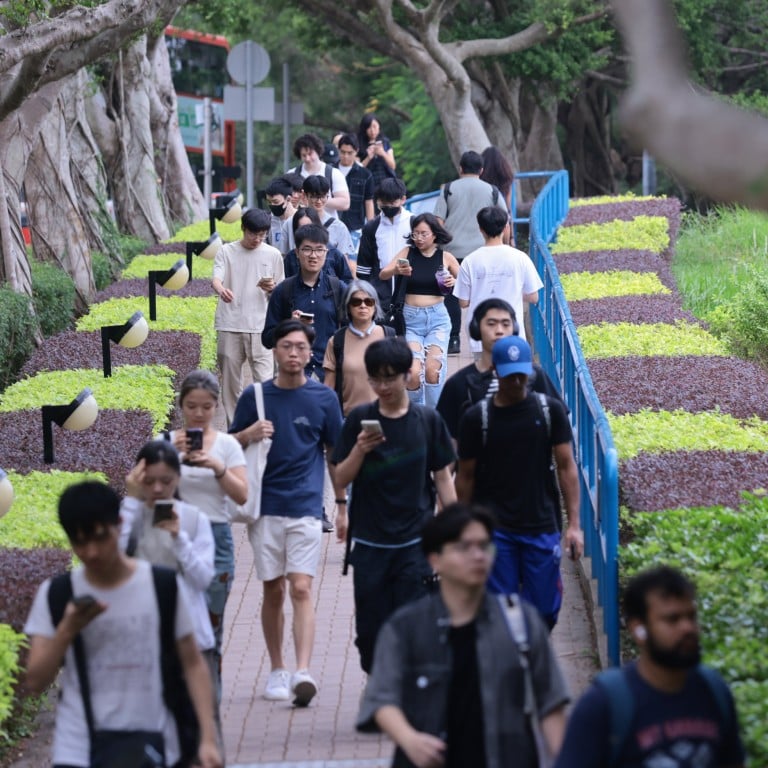
Hong Kong public universities on recruiting blitz for foreign students as mainland Chinese numbers among undergrads soar past 10,000
- Mainlanders make up seven in 10 non-local undergrads, with a drop in students from ‘rest of the world’
- Eight public universities get HK$30 million to go on overseas drives to internationalise their enrolments
The number of mainland Chinese enrolled in undergraduate courses at Hong Kong’s public universities has soared past 10,000 for the first time on record, accounting for about 70 per cent of all non-local students.
The higher proportion is the result of a wider push by the city’s universities to internationalise their student bodies, and one country that has emerged as a target of those efforts is India.
Hong Kong’s eight public universities will embark on a joint recruitment trip to the country in the first half of this year, with one aim being attracting highly sought-after students who excel in maths and are viewed as key to helping the city achieve its long-term development goals.
According to the University Grants Committee (UGC), which allocates funding, Hong Kong has 14,756 non-local undergraduate students enrolled in its public universities. They included 10,358 from the mainland, accounting for 70.2 per cent of all non-local students and up by 50 per cent from six years ago.
Some pupils to sit Hong Kong university entrance exams across border: authority
The data showed that about 4,400 non-local students came from “the rest of the world”, a 15 per cent decrease over five years ago, although the UGC does not provide a breakdown by countries.
Most non-locals majored in the sciences, followed by business and management, engineering and technology.
Chief Executive John Lee Ka-chiu announced last October that the non-local student quota for programmes at publicly funded institutions would double to 40 per cent in September this year.
According to the UGC, the University of Hong Kong (HKU), the Hong Kong University of Science and Technology and Polytechnic University had already exceeded the existing quota and more than 20 per cent of their students were non-locals.
PolyU recorded the highest jump in the proportion of mainland students, rising from 60 per cent in 2018-19 to 84 per cent in the current academic year.
A spokeswoman said the university was committed to building an international campus and had visited more than 30 countries and regions to recruit students in the first half of the current school year.
PolyU last year had more than 29,400 students at all levels of its programmes, who came from more than 70 countries and regions, she noted.
At HKU, the proportion of non-locals from the mainland rose from 54 per cent to 70 per cent between 2018-19 and the current academic year.
A university spokesman said it had established partnerships with overseas institutions to develop immersive programmes and dual-degree ones.
“All these efforts aim to enhance and create a diverse and global learning environment … Currently, we focus on attracting students from countries and places including but not limited to Asia, Europe, America and others,” he said.

The other five public universities are the Chinese University of Hong Kong, City University, Baptist University, Lingnan University and the Education University of Hong Kong.
The UGC gave HK$30 million (US$3.83 million) to the Heads of Universities Committee to promote internationalisation at every publicly funded university for three academic years, up until 2025, a spokeswoman for the grants body said. They can use the funding to join international education expos, organise promotional and student recruitment trips, and carry out marketing activities.
An exhibition to introduce Hong Kong as a study destination will be held next month in Perth, Australia, followed by similar events in the United States in May and in France in September.
“The universities will also embark on a joint recruitment trip to India in the first half of 2024,” the spokeswoman said.
Academic staff departures at Hong Kong universities hit highest since handover
But Hong Kong could expect competition in wooing Indian students as other countries also hoped to attract them. French President Emmanuel Macron last month announced his country aimed to attract 30,000 Indian students by 2030. More than 6,300 Indians were studying in France in the 2021-22 academic year.
Writing on X, formerly known as Twitter, Macron said that having 30,000 Indian students in France by 2030 was “a very ambitious target, but I am determined to make it happen”.
According to Malaysian news outlet Malay Mail, Malaysian High Commissioner to India Muzafar Shah Mustafa announced last month that his country hoped to attract more Indian students as part of initiatives to promote its universities globally.
CityUHK ranked ‘Most International University in the World 2024’ by THE
South Korea announced a plan last August to attract 300,000 international students by 2027, and quotas will be increased for several countries, including India.
Lau Chi-pang, a lawmaker and associate vice-president of Lingnan University, said many countries wanted to attract Indian students because they generally had a sound foundation in maths and science.
“Indian graduates in the United States have been supporting the development of Silicon Valley,” he said. “Hong Kong also wants similar talent to help develop the innovation and technology field.”

